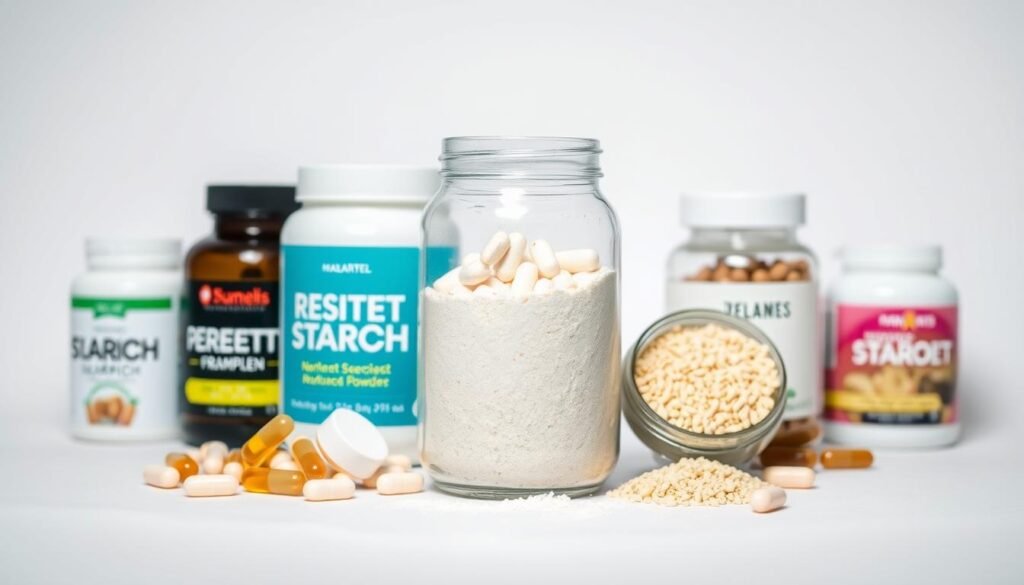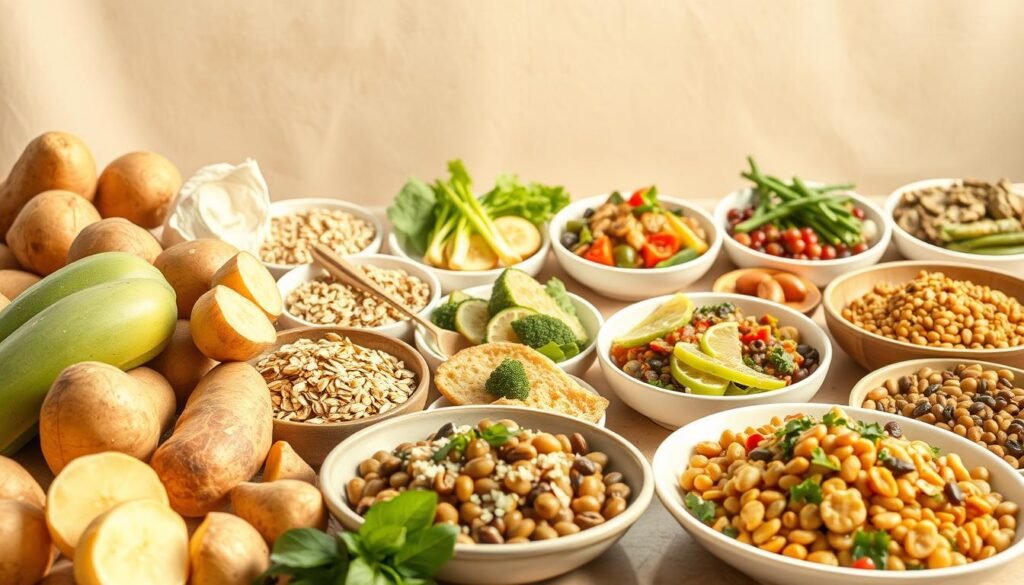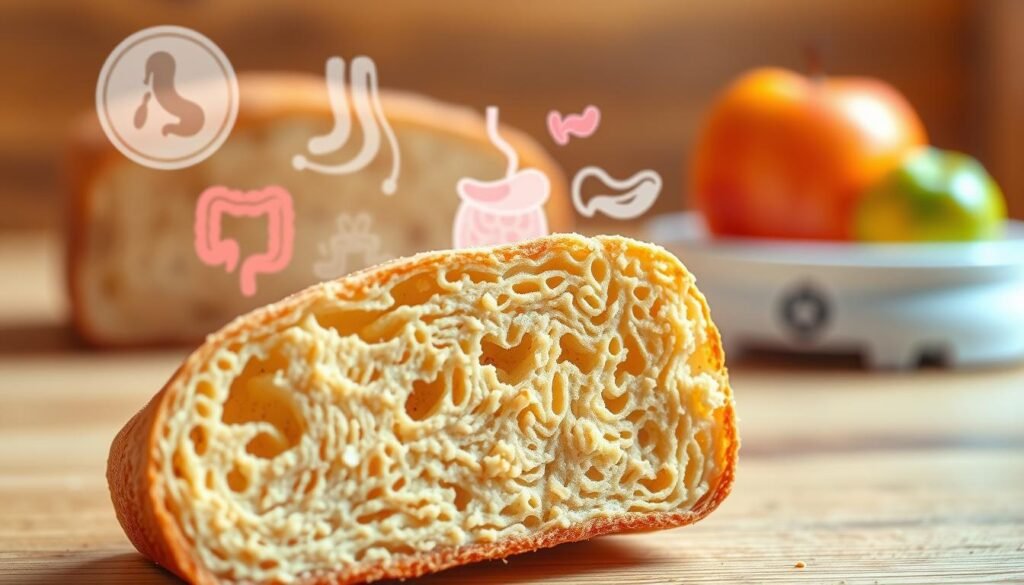Getting to the right weight loss goal and keeping your gut healthy can be tough. But, there’s a simple trick: add a special type of carb to your meals.
Thank you for reading this post, don't forget to subscribe!Resistant starch is a carb that your small intestine can’t digest. It gets broken down in your large intestine, which helps your gut health. This also helps with weight loss by making your body more sensitive to insulin and lowering inflammation.
By choosing the right foods, you can use resistant starch to boost your nutrition and health.
Key Takeaways.
- Incorporating resistant starch into your diet can support weight loss.
- Resistant starch promotes a healthy gut microbiome.
- It improves insulin sensitivity and reduces inflammation.
- A healthy gut is essential for overall nutrition and well-being.
- Making informed dietary choices is key to getting the most from resistant starch.
What Is Resistant Starch?
Resistant starch is a type of starch that our bodies don’t fully digest. It’s special because it acts like dietary fiber, giving us health perks. You can find it in foods like grains, legumes, and some fruits and veggies.
What makes resistant starch important is how it’s not digested in the small intestine. This is where most of our nutrient absorption happens. Instead, it goes to the large intestine, where it gets fermented by our gut bacteria.
The Science Behind Resistant Starch
Resistant starch is special because it’s hard for enzymes to break down. This is due to its crystalline structure. Because of this, it acts like fiber, helping us feel full and supporting our gut health.
In the large intestine, resistant starch gets fermented. This process creates short-chain fatty acids. These acids are vital for a healthy gut. They help feed the cells lining the colon and play a role in many bodily functions.
Different Types of Resistant Starch
There are five types of resistant starch, each with its own benefits and sources. Here’s a quick rundown:
| Type | Description | Sources |
|---|---|---|
| Type 1 | Physically inaccessible starch | Whole grains, seeds |
| Type 2 | Raw starch granules | Raw potatoes, green bananas |
| Type 3 | Retrograded starch | Cooked and cooled potatoes, rice |
| Type 4 | Chemically modified starch | Processed foods |
| Type 5 | Amylose-lipid complex | Certain types of cornflakes |
Knowing about the different types of resistant starch can help you make better food choices. This way, you can get the most health benefits from it.
The Health Benefits of Resistant Staxch
Adding resistant starch to your diet can greatly improve your health. It’s a type of fiber that offers many benefits for your well-being.
Short-Chain Fatty Acids Production
Resistant starch helps make short-chain fatty acids. These acids are vital for a healthy gut. They give energy to the colon’s cells, keeping the gut healthy and reducing inflammation.
Blood Sugar Regulation
Resistant starch also helps control blood sugar levels. It slows down glucose digestion and absorption. This is great for people with diabetes or those at risk of insulin resistance.
Improved Insulin Sensitivity
Resistant starch also boosts insulin sensitivity. It reduces inflammation and supports a healthy gut microbiome. This helps the body use insulin better, lowering the risk of type 2 diabetes. It also aids in weight management and metabolic health.
In summary, resistant starch offers many health benefits. It supports the production of short-chain fatty acids, regulates blood sugar, and improves insulin sensitivity. Adding resistant starch to your diet can help you achieve better health.
Resistant Starch and Weight Loss: The Connection
Resistant starch is key for effective weight loss. It supports a healthy digestive system and helps manage weight.
The link between resistant starch and weight loss is complex. It boosts feelings of fullness, affects metabolic rate, and changes how calories are absorbed.
How Resistant Starch Promotes Satiety
Resistant starch slows down digestion. This gradual release of glucose into the bloodstream reduces hunger and keeps you feeling full longer.
Mechanisms behind satiety promotion:
- Slower gastric emptying
- Increased production of satiety hormones like PYY and GLP-1
- Enhanced feelings of fullness due to the gel-like texture it forms in the stomach
Impact on Metabolic Rate
Resistant starch also affects metabolic rate. It can boost fat burning, leading to weight loss.
Reduced Calorie Absorption
Resistant starch reduces calorie absorption from food. It resists digestion in the small intestine, lowering energy from carbs.
| Mechanism | Effect on Weight Loss |
|---|---|
| Promotes Satiety | Reduces overall calorie intake |
| Impacts Metabolic Rate | Increases fat burning |
| Reduces Calorie Absorption | Lowers net calorie intake |
Adding resistant starch to your diet can help with weight loss. It uses these mechanisms to support your efforts.
Gut Health and Resistant Starch
Resistant starch is great for gut health. It acts as a prebiotic, helping the gut microbiome. This complex carb isn’t fully digested in the small intestine. Instead, it’s fermented by bacteria in the large intestine, making short-chain fatty acids.
These acids give energy to colon cells. They also help keep the gut healthy.

Prebiotic Effects on Gut Microbiome
The prebiotic effects of resistant starch encourage good bacteria growth in the gut. This boosts the gut microbiome’s diversity and strength. Dr. Jane Smith, a top gastroenterologist, says, “A diet rich in prebiotics like resistant starch is key for a healthy gut balance.”
This balance is vital for a strong immune system and overall health.
Inflammation Reduction in the Digestive Tract
Resistant starch also has anti-inflammatory properties. It lowers pro-inflammatory cytokine production. This makes the digestive tract less inflamed, which is good for those with gut issues.
Improved Gut Barrier Function
A strong gut barrier stops toxins and undigested food from entering the bloodstream. Resistant starch helps keep the gut barrier strong. It does this by boosting tight junction proteins, improving barrier function and lowering leaky gut risk.
In summary, resistant starch is good for gut health in many ways. It supports the gut microbiome, reduces inflammation, and improves barrier function. Adding resistant starch-rich foods to your diet can help keep your gut healthy.
Complete Guide to Resistant Starch Foods
Knowing which foods are high in resistant starch is key to getting its health benefits. Resistant starch is in many foods, making it easy to add to your meals. The main sources are grains and cereals, legumes and pulses, fruits and vegetables, and nuts and seeds.
Grains and Cereals
Grains and cereals are big sources of resistant starch, more so when cooked and cooled. Cooked rice becomes a good source after it’s chilled. Other grains like oats and barley also have resistant starch, best when whole or less processed.
| Food | Resistant Starch Content |
|---|---|
| Cooked and cooled rice | High |
| Oats | Moderate |
| Barley | Moderate |
Legumes and Pulses
Legumes and pulses are not just high in protein but also in resistant starch. Foods like lentils, chickpeas, and kidney beans are great sources. They’re versatile and can be used in many dishes, from soups to salads.
Fruits and Vegetables
Some fruits and vegetables have resistant starch, mainly when not fully ripe. Green bananas and raw potatoes are known sources. Other veggies like peas and corn are good when raw or lightly cooked.
Nuts and Seeds
Nuts and seeds are also rich in resistant starch. While not all are equal, almonds and cashews stand out. Adding different nuts and seeds to your diet boosts resistant starch intake.
By adding these foods to your diet, you can up your resistant starch levels. This can improve your gut health and overall well-being.
The Cooling Effect: How Food Preparation Increases Resistant Starch
Cooking and cooling foods can boost resistant starch levels. This process, called retrogradation, makes meals more nutritious.
The Science of Retrogradation
Retrogradation happens when cooked starches cool down. The starch molecules then line up better, making them harder for the body to digest. This boosts the resistant starch, which is good for gut health and nutrition.
Key Factors in Retrogradation:
- Cooking method: Boiling or steaming makes starches more ready for retrogradation.
- Cooling time: Slow cooling of cooked foods helps more.
- Storage conditions: Keeping foods in the fridge increases resistant starch.
Step-by-Step Cooling Methods for Maximum Benefits
To get more resistant starch, follow these steps:
- Cook your food as usual, making sure it’s fully gelatinized.
- Let the cooked food cool to room temperature.
- Put the cooled food in the fridge for at least 24 hours before eating.
| Food | Cooking Method | Resistant Starch Increase |
|---|---|---|
| Potatoes | Boiling | Up to 13% |
| Rice | Steaming | Up to 10% |
| Banana | Raw | Up to 5% |
Using these cooling methods in your cooking can greatly increase resistant starch. This is good for your gut health and nutrition.
How to Gradually Introduce Resistant Starch Into Your Diet
To enjoy the benefits of resistant starch, start by adding it slowly to your meals. This helps your gut adjust, avoiding any discomfort. A gradual introduction is key for better digestion and health.
Starting Small: The Importance of Slow Integration
Start with small amounts of resistant starch, about 5-10 grams a day. You can find this in a small banana or a cooled tablespoon of rice. This slow start helps your body get used to it, reducing the chance of bloating or gas.
Benefits of slow integration include:
- Reduced risk of digestive discomfort
- Gradual adjustment of gut bacteria
- Improved tolerance to higher amounts of resistant starch
Week-by-Week Plan for Adaptation
For a smoother introduction, follow a week-by-week plan. Week 1: Start with 5 grams a day. Week 2: Increase to 10 grams a day. Keep adding more each week until you reach your goal.
This gradual increase helps your body adjust, making it easier to add resistant starch to your diet.
Monitoring Your Body’s Response
Keep an eye on how your body reacts to resistant starch. Notice any changes, good or bad. If you feel uncomfortable, slow down or talk to a health expert for advice.
Key indicators to monitor:
- Changes in bowel movements
- Levels of bloating or gas
- Overall digestive comfort
Resistant Starch Supplements: Do They Work?
Resistant starch supplements have gained popularity for boosting gut health and aiding in weight loss. Many people look for easy ways to better their diet, and supplements are a common choice. But do these supplements really work as well as natural sources of resistant starch?

Types of Resistant Starch Supplements
There are different types of resistant starch supplements, like capsules, powders, and tablets. These products often use resistant starch from potatoes, corn, or tapioca. Some may also add other fibers or prebiotics to boost their benefits. It’s important to check the type of resistant starch and any extra ingredients in a supplement.
Key Considerations:
- Source of resistant starch
- Additional ingredients
- Manufacturing process
Comparing Natural Sources vs. Supplements
While supplements are handy for boosting resistant starch intake, natural sources offer a more complete nutrition. Foods like whole grains, legumes, and some fruits and veggies are full of resistant starch and other nutrients. As Dr. Jane Smith, a nutrition expert, says, “Eating natural sources of resistant starch gives you a better nutritional balance than just taking supplements.”
A study in a well-known nutrition journal showed that eating natural resistant starch improved gut health more than supplements did. This shows the value of both the ease of supplements and the health benefits of whole foods.
“The best way to get the benefits of resistant starch is through a balanced diet that includes a variety of whole foods.” –
In summary, while resistant starch supplements can be helpful, they shouldn’t replace natural sources. A mix of supplements and whole foods offers the best benefits.
Common Mistakes When Adding Resistant Starch to Your Diet
Adding resistant starch to your meals can be a big help. But, it’s important to avoid common mistakes. These mistakes can make you feel uncomfortable and reduce the benefits.
Increasing Intake Too Quickly
One big mistake is adding too much resistant starch at once. This can cause bloating and gas. It’s better to slowly increase your intake to let your body get used to it.
Ignoring Individual Tolerance Levels
Not considering how your body reacts to resistant starch is another mistake. Everyone’s body is different. It’s important to listen to how your body feels and adjust your intake.
Overlooking Hydration Needs
Not drinking enough water is another common error. Resistant starch can make you constipated if you don’t drink enough. Drinking plenty of water is key when you’re adding resistant starch to your diet.
Knowing these mistakes and avoiding them can help you get the most out of resistant starch. This way, you can enjoy a healthier diet.
Resistant Starch Recipes for Breakfast
Start your day with breakfast ideas that are both tasty and good for you. Adding resistant starch to your morning meal can help your digestion. It also gives you energy that lasts all morning.
Overnight Oats with Green Banana
Try making overnight oats with green banana for a tasty breakfast. Mix rolled oats, sliced green banana, and milk in a jar. Refrigerate it overnight and add nuts or seeds in the morning. This dish is full of resistant starch, fiber, and vitamins.
Chilled Rice Pudding
Chilled rice pudding is another great breakfast choice. Cook rice with milk and a bit of sugar, then chill it. The cooling process makes it even higher in resistant starch. You can add cinnamon or vanilla for extra flavor. It’s a healthy way to begin your day.
Bean and Vegetable Breakfast Bowl
For a savory breakfast, try a bean and vegetable bowl. Cook beans like black beans or chickpeas and mix with sautéed veggies like spinach and bell peppers. Serve over cooled rice or quinoa to add more resistant starch. This bowl is full of protein, fiber, and resistant starch, making it a nutritious start.
These breakfast recipes are not only yummy but also full of nutrients. They can improve your gut health and overall well-being. By adding resistant starch to your breakfast, you’re taking a big step towards a healthier life.
Lunch and Dinner Ideas Rich in Resistant Starch
You can make your meals better by adding resistant starch. It’s easy to do with simple, tasty changes to your meals.
Bean and Lentil Salads
Bean and lentil salads are great for getting more resistant starch. They’re full of protein and fiber, making you feel full. To make a bean salad, mix cooked beans with onions, tomatoes, and cucumbers. Dress it with a vinaigrette.
Lentil salads work the same way, using cooked lentils. Adding cooled, cooked beans or lentils to your salads boosts their resistant starch.
Potato and Rice Dishes
Potatoes and rice are common foods that can be made into resistant starch-rich dishes. Boil potatoes and then cool them to increase their resistant starch. A potato salad made with cooled, boiled potatoes is a tasty side dish.
Rice dishes can also be made with more resistant starch. Cook and then cool the rice. This process, called retrogradation, turns some starches into resistant starch. Try a cold rice salad with veggies and a light dressing for a healthy meal.
Cooling Techniques for Everyday Meals
Cooling your meals is a simple way to add resistant starch. Let your meals cool down to room temperature or chill them in the fridge. This works for pasta, potatoes, and rice.
By cooling your meals, you can effortlessly boost their nutritional value. For example, cook pasta, let it cool, and then mix it with veggies and a light dressing. It’s a quick, healthy meal.
Snack Options Featuring Resistant Starch Foods
Adding resistant starch to your snacks can boost your health. These snacks are not only tasty but also good for you. Here are some tasty ways to add resistant starch to your snacks.
Green Banana Smoothies
Green banana smoothies are a great snack. Blend green bananas with milk or yogurt and add cinnamon or nutmeg for flavor. They’re full of resistant starch, making them a healthy choice. You can also add spinach or protein powder for extra nutrition.
Chickpea and Bean Dips
Chickpea and bean dips are tasty and full of resistant starch. Make a dip by blending chickpeas or beans with tahini, garlic, and lemon juice. Enjoy with veggies or whole grain crackers for a filling snack. You can season them with herbs and spices to taste.
Seed and Nut Mixes
Seed and nut mixes are easy and healthy snacks. Mix raw or roasted nuts and seeds like almonds, pumpkin seeds, and chia seeds. They’re full of resistant starch, healthy fats, and protein. Add dried fruits or cinnamon for extra flavor.
| Snack Option | Resistant Starch Content | Preparation Tip |
|---|---|---|
| Green Banana Smoothie | High | Blend with milk or yogurt |
| Chickpea Dip | High | Blend with tahini and garlic |
| Seed and Nut Mix | Moderate | Combine raw or roasted nuts and seeds |
Adding these snacks to your diet can improve your gut health and make you feel fuller. Try different recipes and ingredients to find your favorite resistant starch snacks.
Potential Side Effects and How to Manage Them
Resistant starch has many benefits, but knowing its side effects is key. When people add resistant starch to their diet, they might face some issues. These problems usually happen in the digestive system.
Digestive Discomfort and Bloating
One common side effect is digestive discomfort, which can cause bloating. This happens because resistant starch is broken down by gut bacteria, leading to gas. To deal with this, start with small amounts and slowly increase them. This lets your gut adjust.
Gas and Flatulence
Gas and flatulence come from the breakdown of resistant starch. These symptoms might be uncomfortable but usually go away. To reduce gas, try eating smaller meals more often. Also, drink plenty of water to help with digestion.
Strategies for Minimizing Side Effects
To lessen the side effects of resistant starch, try these tips:
- Gradually increase your intake of resistant starch to help your gut adjust.
- Watch how your body reacts and adjust your diet as needed.
- Drink enough water to help with digestion.
Using these strategies can help you enjoy the benefits of resistant starch without the discomfort.
Special Considerations for Different Dietary Needs
Resistant starch can be great for keto or vegan diets if done right. It’s important to think about how to add it to your meals, depending on your diet.

Resistant Starch on Keto and Low-Carb Diets
On keto or low-carb diets, pick resistant starch that’s low in carbs. Green bananas are a good choice because they have fewer carbs than ripe ones. Also, cooling cooked potatoes or rice boosts their resistant starch without adding many carbs.
Vegan and Vegetarian Sources
Vegans and vegetarians can find resistant starch in plant foods. Legumes like lentils and chickpeas are full of it, along with protein and fiber. Green bananas, cooled cooked rice, and corn are also great options.
Gluten-Free Options
Gluten-free diets can get resistant starch from rice, corn, potatoes, and sweet potatoes. Some gluten-free flours also have high resistant starch, adding more choices.
Knowing about resistant starch in various diets helps you make better food choices. This way, you can meet your nutritional needs and enjoy your meals.
Conclusion: Making Resistant Starch a Sustainable Part of Your Diet
Adding resistant starch to your meals can greatly improve your health. Knowing its benefits and where to find it helps you make better choices. This can boost your gut health and aid in weight loss.
Creating a diet rich in resistant starch is doable. Start by slowly adding foods high in resistant starch to your meals. Pay attention to how your body reacts. Try out different recipes to find what works best for you.
With a diet that includes resistant starch, you can keep your gut healthy. It also helps control blood sugar and supports your health goals. Making resistant starch a regular part of your diet can bring lasting health benefits and a more balanced life.
FAQ
What is resistant starch and how does it work?
Resistant starch is a type of fiber that your body can’t digest in the small intestine. It gets broken down in the large intestine, creating short-chain fatty acids. This helps keep your gut healthy.
What are the different types of resistant starch?
There are five types of resistant starch, each with its own benefits. RS1, RS2, RS3, RS4, and RS5 can be found in foods like grains, legumes, and starchy vegetables.
How does resistant starch help with weight loss?
Resistant starch helps you feel full, absorbs fewer calories, and boosts your metabolism. It’s a great tool for losing weight.
Can resistant starch improve gut health?
Yes, it has prebiotic effects. This reduces inflammation and improves the gut barrier, leading to a healthier gut microbiome.
What foods are rich in resistant starch?
Foods high in resistant starch include grains, legumes, fruits, vegetables, and nuts. Examples are oats, barley, lentils, green bananas, and cooled potatoes.
How can I increase the resistant starch content in my meals?
Cooling cooked foods like rice and potatoes increases their resistant starch. This is called retrogradation.
Can I take resistant starch supplements?
Yes, you can find resistant starch supplements. But, compare them to natural sources and consider the quality and type of supplement.
How do I introduce resistant starch into my diet gradually?
Start with small amounts and gradually increase. Watch how your body reacts and adjust as needed.
What are the possible side effects of consuming resistant starch?
Side effects might include digestive discomfort, bloating, gas, and flatulence. These can be lessened by starting slowly and monitoring your body’s response.
Can resistant starch be incorporated into special diets?
Yes, it can be added to keto, low-carb, vegan, vegetarian, and gluten-free diets. Just choose the right foods carefully.
How can I make resistant starch a sustainable part of my diet?
Include resistant starch-rich foods in your meals. Try new recipes and pay attention to how your body reacts. This way, you can make it a lasting part of your diet.
